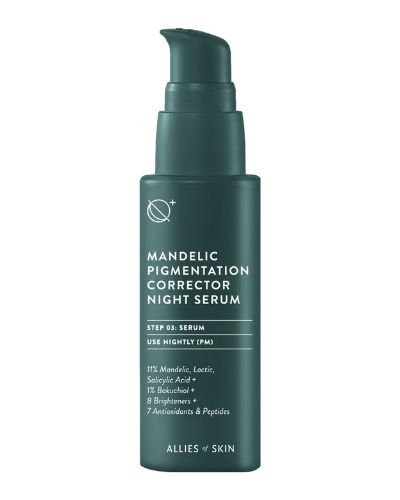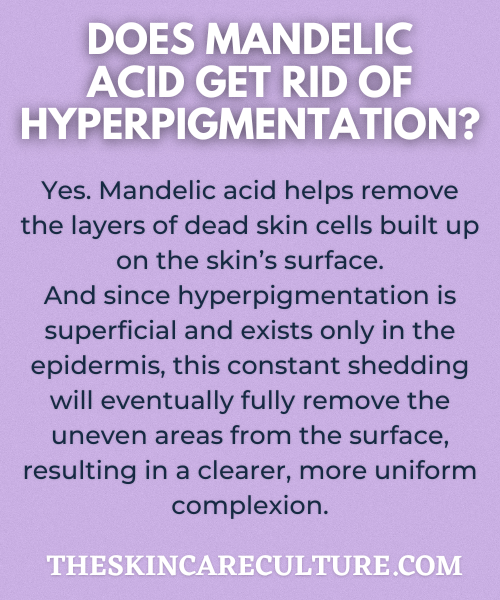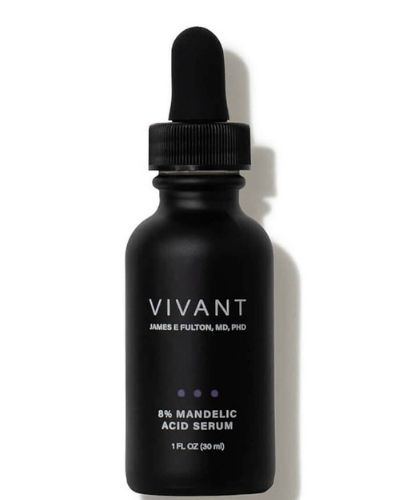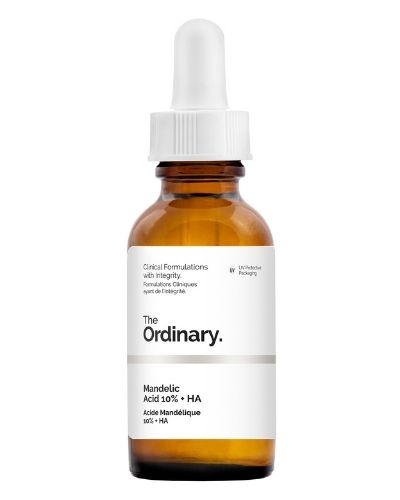Hyperpigmentation or dark spots is a skin issue that many people are looking to overcome.
The good news is that many over-the-counter products include ingredients that can successfully address this specific concern.
Mandelic acid is one that falls in the category of these beneficial ingredients, therefore in this article, I will talk about how this ingredient gets rid of hyperpigmentation and how to introduce it into your daily skincare routine.

What is Mandelic Acid?
Mandelic acid is an alpha hydroxy acid (AHA) that is used to exfoliate the skin. It’s used to address skin issues such as acne, hyperpigmentation, sun damage, and visible signs of aging.
Mandelic acid is used in over-the-counter skincare products and in professional chemical peels. It is one of the most gentle alpha-hydroxy acids, so it can be safely used by a wide range of skin types and various skin conditions.
What is Hyperpigmentation?
Hyperpigmentation is a common condition that manifests itself as patches or spots on the skin that are darker than the surrounding areas.
This occurs when the melanocyte cell produces an abnormal amount of the brown pigment melanin which then builds up in smaller areas across the layers of the skin.
This reaction could be the result of several factors, including old age and cell damage, sun damage, irregularities in melanin deposition due to inflammation (i.e after a pimple has healed), as well as hormonal imbalances that lead to conditions such as melasma.
How Does Mandelic Acid Fade Hyperpigmentation?

Mandelic acid helps remove the layers of dead skin cells built up on the skin’s surface.
And since hyperpigmentation is superficial and exists only in the epidermis, this constant shedding will eventually fully remove the uneven areas from the surface, resulting in a clearer, more uniform complexion.
Additionally, mandelic acid is a great anti-acne ingredient that helps clear out the pores and prevent them from becoming clogged with hardened sebum and dead skin cells.
This will prevent acne breakouts that would otherwise lead to hyperpigmentation and will eliminate one cause of uneven skin tone by keeping the skin clear and free from inflammation.
RELATED: Best Serums for Hyperpigmentation.

How Long Does it Take to Treat Hyperpigmentation with Mandelic Acid?
Fading hyperpigmentation with mandelic acid can take anywhere from several weeks to several months, and it depends on a few things, including your skin type, the cause of hyperpigmentation, how well your skin agrees with your treatment, how well you take care of your skin, etc.
On the other hand, it’s important to note that mandelic acid does not treat all types of hyperpigmentation the same and a lot has to do with the strength as well as the products you combine it with.
For example, mandelic acid might prove itself useful in fading hyperpigmentation left from old acne but it might not be so successful in treating uneven skin tone caused by sun damage, especially if you are using mandelic acid but not applying sunscreen in the morning.
Lastly, the strength you are using will also have a lot to do with the results you will experience.
For example, getting one or two professional mandelic acid peels will give your skin a great advantage and will get rid of more stubborn hyperpigmentation quicker than a regular product would.
You can then continue to use over-the-counter mandelic acid products to maintain healthy and clear skin.
How To Start Using Mandelic Acid?

Active ingredients such as mandelic acid should be used in your evening routine. You can start by incorporating mandelic acid up to three times a week, assuming you are not using any other type of exfoliator.
However, if you are also using other chemical exfoliators, it is best to keep it lower than that and you can use mandelic acid once a week or once every two weeks, depending on your skin’s needs.
Initial tingling and sensitivity are normal, especially if your skin is sensitive.
However, if this initial tingling becomes uncomfortable burning, this means that the product may be too strong for you or your skin is overly sensitive so you should wash it off and opt for something milder.
Additionally, make sure to always follow up with a high SPF in the morning as mandelic acid, like all other chemical exfoliants, can make your skin sensitive to the sun.
Additionally, I have seen people asking online whether it’s safe to use mandelic acid if they have a nut allergy since mandelic acid is derived from bitter almonds.
Mandelic acid isn’t a protein, therefore it should be safe for use as people with nut allergies are typically sensitive to the proteins found in nuts.
However, it is always best to play it safe, so you should either consult with your health provider before starting to use mandelic acid if you have a nut allergy or do a patch test of products that contain mandelic acid on the inner wrist or behind the ear before trying them out on the entire face.
What Else Can You Use to Treat Hyperpigmentation Besides Mandelic Acid?
Other ingredients that treat hyperpigmentation are:
Azelaic acid – helps fade post-inflammatory hyperpigmentation and does not cause cellular turnover like some exfoliating acids and retinoids. Because of this, azelaic acid is the best option for sensitive and reactive skin.
Niacinamide – helps to reduce hyperpigmentation by inhibiting the transfer of melanosomes from melanocytes to keratinocytes (skin cells).
Retinol – works by increasing cell turnover, which allows for new skin cells to come to the surface and reduce pigmented particles attached to dead cells that contribute to uneven patches. This ingredient does take a little longer to show results but it’s one of the most effective options for fading hyperpigmentation.
Vitamin C – a free-radical fighting agent that helps reduce hyperpigmentation caused by sun damage.
Lactic acid – another super gentle AHA that helps shed uneven skin tone and encourage a unified and even complexion.
What Are Some Possible Side Effects of Mandelic Acid?

Mandelic acid does not cause side effects in most people, however, overusing it can sometimes lead to dryness and irritation.
Additionally, since it’s an alpha hydroxy acid and works on the surface of the skin, mandelic acid can also make the skin more sensitive to the sun.
This is why it’s important to wear high SPF when starting to use mandelic acid and to not exfoliate more than 2-3 times a week.
Conclusion
If you are looking for a safe and effective way to treat hyperpigmentation, Mandelic Acid is one of the best solutions.
Usual over-the-counter options can take a bit longer to see results, but it is still effective in most cases!

My name is Simone and I am a certified skin specialist. I created this website to teach my readers how to take great care of their skin and I also like to occasionally share my honest opinions on skincare products I’ve tried. You can learn more about me here.
